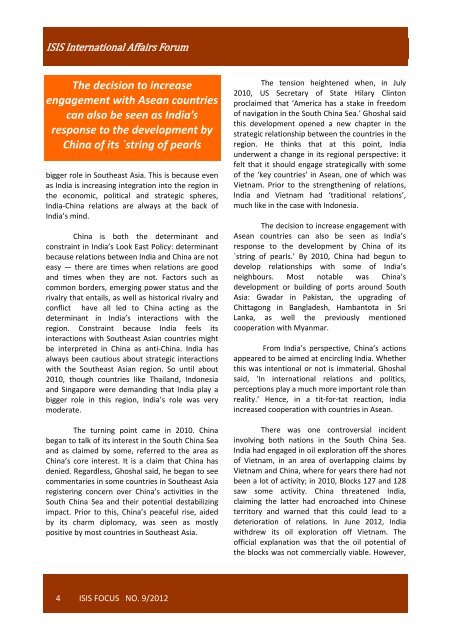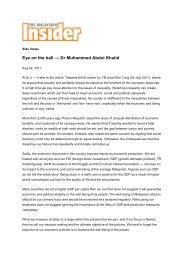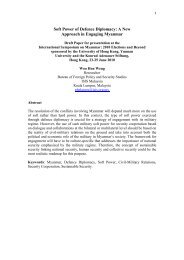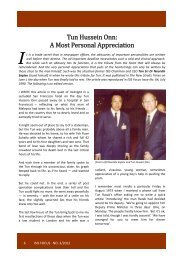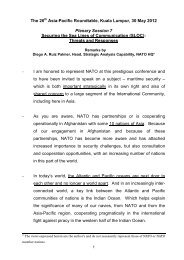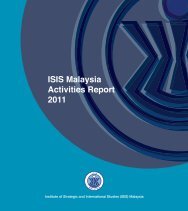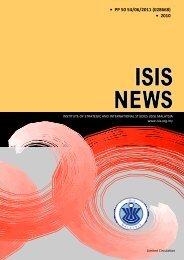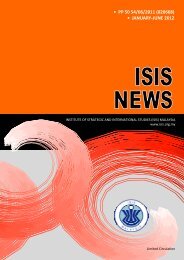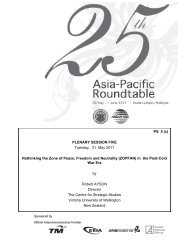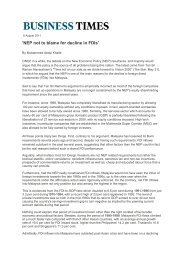India's Look East Policy - ISIS Malaysia
India's Look East Policy - ISIS Malaysia
India's Look East Policy - ISIS Malaysia
You also want an ePaper? Increase the reach of your titles
YUMPU automatically turns print PDFs into web optimized ePapers that Google loves.
<strong>ISIS</strong> International Affairs Forum<br />
The decision to increase<br />
engagement with Asean countries<br />
can also be seen as India’s<br />
response to the development by<br />
China of its `string of pearls<br />
bigger role in Southeast Asia. This is because even<br />
as India is increasing integration into the region in<br />
the economic, political and strategic spheres,<br />
India‐China relations are always at the back of<br />
India’s mind.<br />
China is both the determinant and<br />
constraint in India’s <strong>Look</strong> <strong>East</strong> <strong>Policy</strong>: determinant<br />
because relations between India and China are not<br />
easy — there are times when relations are good<br />
and times when they are not. Factors such as<br />
common borders, emerging power status and the<br />
rivalry that entails, as well as historical rivalry and<br />
conflict have all led to China acting as the<br />
determinant in India’s interactions with the<br />
region. Constraint because India feels its<br />
interactions with Southeast Asian countries might<br />
be interpreted in China as anti‐China. India has<br />
always been cautious about strategic interactions<br />
with the Southeast Asian region. So until about<br />
2010, though countries like Thailand, Indonesia<br />
and Singapore were demanding that India play a<br />
bigger role in this region, India’s role was very<br />
moderate.<br />
The turning point came in 2010. China<br />
began to talk of its interest in the South China Sea<br />
and as claimed by some, referred to the area as<br />
China’s core interest. It is a claim that China has<br />
denied. Regardless, Ghoshal said, he began to see<br />
commentaries in some countries in Southeast Asia<br />
registering concern over China’s activities in the<br />
South China Sea and their potential destabilizing<br />
impact. Prior to this, China’s peaceful rise, aided<br />
by its charm diplomacy, was seen as mostly<br />
positive by most countries in Southeast Asia.<br />
The tension heightened when, in July<br />
2010, US Secretary of State Hilary Clinton<br />
proclaimed that ‘America has a stake in freedom<br />
of navigation in the South China Sea.’ Ghoshal said<br />
this development opened a new chapter in the<br />
strategic relationship between the countries in the<br />
region. He thinks that at this point, India<br />
underwent a change in its regional perspective: it<br />
felt that it should engage strategically with some<br />
of the ‘key countries’ in Asean, one of which was<br />
Vietnam. Prior to the strengthening of relations,<br />
India and Vietnam had ‘traditional relations’,<br />
much like in the case with Indonesia.<br />
The decision to increase engagement with<br />
Asean countries can also be seen as India’s<br />
response to the development by China of its<br />
`string of pearls.’ By 2010, China had begun to<br />
develop relationships with some of India’s<br />
neighbours. Most notable was China’s<br />
development or building of ports around South<br />
Asia: Gwadar in Pakistan, the upgrading of<br />
Chittagong in Bangladesh, Hambantota in Sri<br />
Lanka, as well the previously mentioned<br />
cooperation with Myanmar.<br />
From India’s perspective, China’s actions<br />
appeared to be aimed at encircling India. Whether<br />
this was intentional or not is immaterial. Ghoshal<br />
said, ‘In international relations and politics,<br />
perceptions play a much more important role than<br />
reality.’ Hence, in a tit‐for‐tat reaction, India<br />
increased cooperation with countries in Asean.<br />
There was one controversial incident<br />
involving both nations in the South China Sea.<br />
India had engaged in oil exploration off the shores<br />
of Vietnam, in an area of overlapping claims by<br />
Vietnam and China, where for years there had not<br />
been a lot of activity; in 2010, Blocks 127 and 128<br />
saw some activity. China threatened India,<br />
claiming the latter had encroached into Chinese<br />
territory and warned that this could lead to a<br />
deterioration of relations. In June 2012, India<br />
withdrew its oil exploration off Vietnam. The<br />
official explanation was that the oil potential of<br />
the blocks was not commercially viable. However,<br />
4 <strong>ISIS</strong> FOCUS NO. 9/2012


